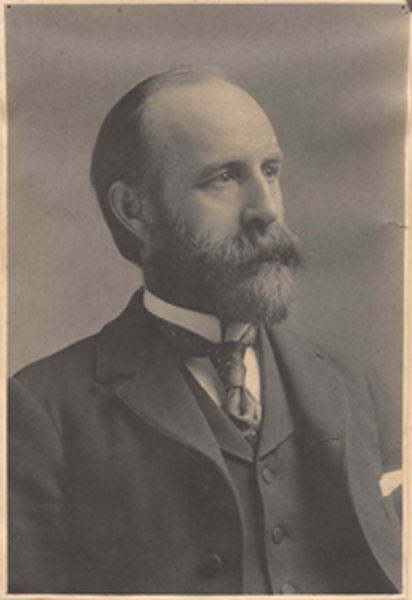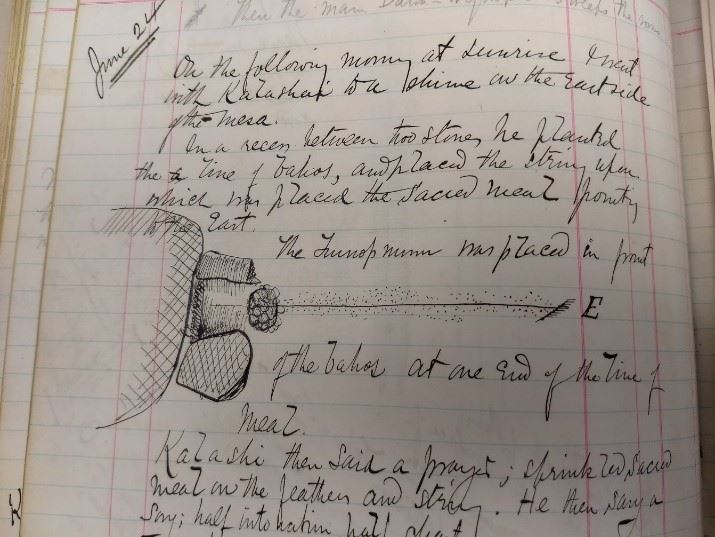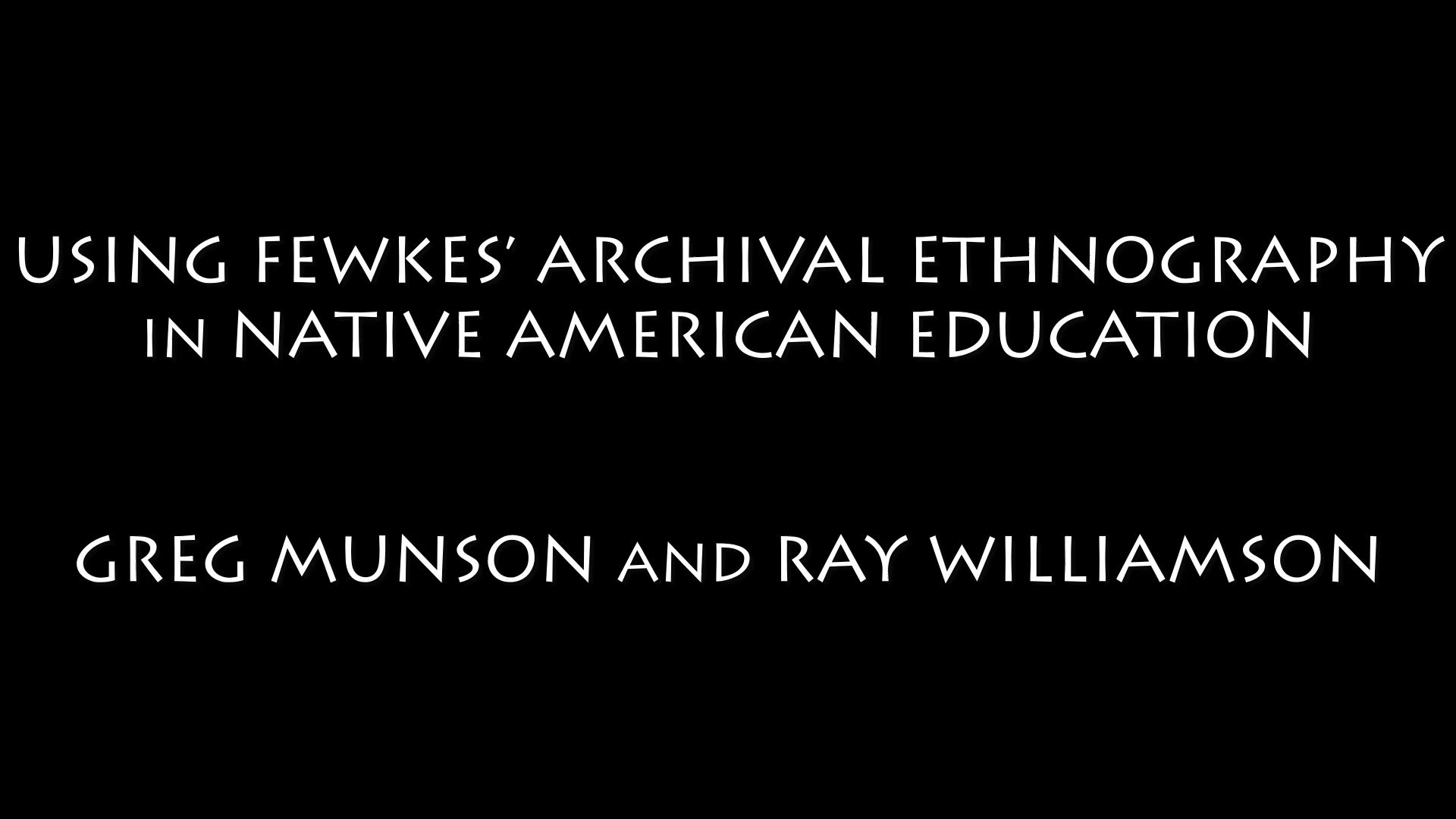Fewkes Digital Archive Project

From the 1880s through the 1920s, Dr. Jesse Walter Fewkes made a substantial contribution to our knowledge of Native American ethnology and of Southwest archaeology. After earning his doctorate in marine biology, Fewkes joined the Hemenway Southwestern Archaeological Expedition to the American Southwest and soon turned to documenting the cultures of the Hopi and Zuni Pueblos. His highly detailed notebooks, drawings and photographs form a historically significant collection of early ethnographic material about these Native Americans. He also made important contributions in archaeology, working at what is now Casa Grande Ruins National Monument, Mesa Verde National Park and many other archeological sites throughout the Southwest.
Our interest in his work came about because unlike many other archeologists and ethnographers, Dr. Fewkes had an interest in how Southwest Native Americans viewed and responded to sun, moon and stars. He was also one of the early documentarians of archaeological sites we have studied, taking some of the earliest photographs known of these structures and investigating their probable use. Fewkes invited Native American artists to share their images of rock art, Hopi katsinas and other aspects of Hopi and Zuni culture, which are included in the archival collection. Fewkes was even one of the first ethnographers to use the newly developed audio recording techniques to document Native American music and language. He was an important voice in arguing for the preservation of archaeological sites in the Southwest and elsewhere in the United States.
Dr. Jesse Walter Fewkes
In our preliminary investigations of Fewkes’ fragile notebooks and other archival information now stored in the Smithsonian Institution’s National Anthropological Archives (NAA) outside of Washington, DC, we came to realize that they were a treasure trove of information, some of which never made it into his published papers and reports to the Bureau of American Ethnology. Although they are well housed and protected in the NAA, the notebooks have deteriorated and should be digitized to ensure that the information they contain is preserved for posterity, for the benefit of the Hopi and Zuni Pueblos and for researchers.
We propose to initiate a Fewkes Digital Archive Project under SCAAS auspices that will be pursued in two phases: 1) a pilot project to investigate fully the feasibility and costs of digitizing Fewkes’ entire archival collection housed in the NAA, and 2) a project to have the NAA carry out the digitization and make the material available to a broad public through the NAA.
Pilot Project:This phase of the overall effort will focus on visiting the NAA for several days, viewing and photographing as much of the collection as we can to develop a proposal for documenting the entire collection. We estimate that this phase would cost between $5,000 and $7500 for travel, food and lodging and would ensure that two or possibly three persons are able to complete the development of the full project proposal. We have identified a possible granting entity for part of these funds, but will also need additional funding to match the grant. Donations to the Society are the basis for these matching funds. To date we have received a total of $250.00 in donations to this project from members and supporters. Members of the SCAAS Board of Directors have pledged an additional $500.00 in donations which will be fulfilled by years’ end. We need to raise a total of $3,500.00 in matching funds. Donations can be made by credit card below, by downloading the donation form and sending a check or by signing up for one of our Sponsor Memberships. All donors and their support will be recognized on the upcoming Fewkes Digital Archive Project page on our website. Any new sponsor level memberships (Patron, Sustaining, Sponsor or Lifetime) or donations of $500.00 or more will receive a complimentary copy of our 2016 conference publication Before Borders: Revealing the Greater Southwest’s Ancestral Cultural Landscape and a SCAAS gift set .

Example of a page from Fewkes’ notebook from Hopi, 1891: “On the following morning at sunrise, I went with Ka’lacai to a shrine on the east side of the mesa. In a recess between two stones he planted the line of bahos (prayer sticks) and placed the string upon which he placed the sacred meal pointing to the east. The Turnopa (an offering of food) was placed in front of the bahos at one end of the line of meal.” The drawing of the shrine is an example of an element of the notebooks that did not appear in his published description of the occasion.
Digital Archive Project: Once we have the information from the pilot project, we will use those results to develop a much larger proposal to attract sufficient funding (likely $70,000 - $100,000). The NAA will contract with a firm to complete the digitization and make the results available to the public. We have identified interest on the part of some Hopi tribal members in the project and hope to bring them into it as soon as feasible.
Value of the Records
1. Assist Native American education to:
a. Learn what Fewkes witnessed and recorded.
b. Recover lost information.
2. Ethnographic research
a. Land use and ownership.
b. Interpretation of pictographs and petroglyphs.
3. Archaeological research
a. Assess condition of sites before repair work.
b. Confirmation of feature origin.
c. Architectural studies.
We think that these records and photographs have immense value to the tribes he documented and the anthropological research community for interpreting the architecture of the sites he excavated and repaired as well as the cultures he studied. The records we examined are but a small percentage of his collection housed at the Smithsonian Institution. The notebooks are raw data on the Hopi and Zuni way of life at that time. They have detailed color drawings and recorded information that may have been lost by modern Hopi and Zuni Societies. Such a project would be completed with close cooperation and consultation of Native American tribal entities to ensure that sensitive information or images would be protected. Even though there are many challenges, we should not be deterred from this type of undertaking. The acidic records themselves are slowly deteriorating into the dust of the ages and it is our responsibility to make sure that the efforts of our archaeological ancestors live into the future for the benefit of generations yet to come.
Fewkes Digital Archive YouTube Video
Project Coordinators:
Gregory E. Munson and Ray A. Williamson
Project Donors:
Mark Raney Ingrid Wood Mary Anne Munson
Bryan Bates Ray A. Williamson Gregory E. Munson
Ric Alling Jo Anne & Bill Mowczko Chris Dombrowski
Dr. Gordon Houston Virginia Wolf William Seven
Mary Weahkee Carol Patterson
Pilot Project Donation's Goal: $5,000.00 Donations to date: $1,370.00
